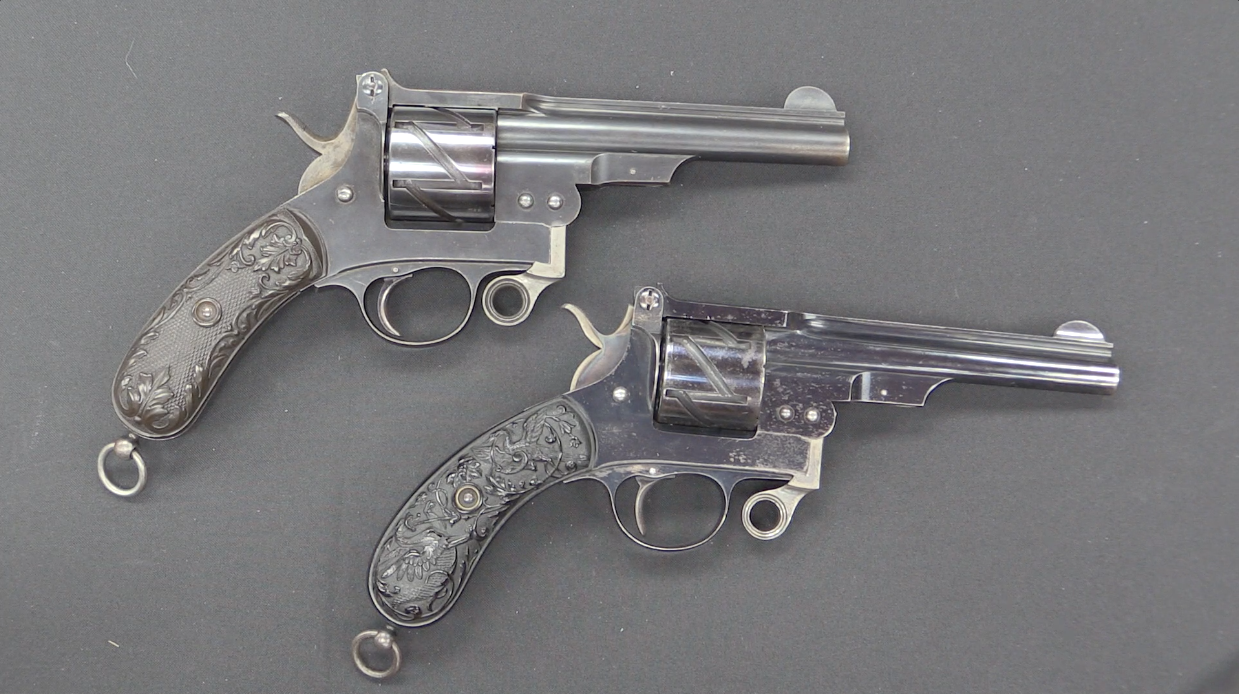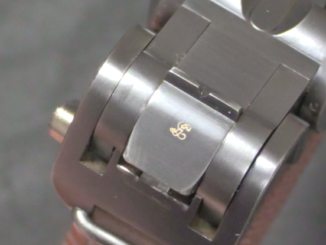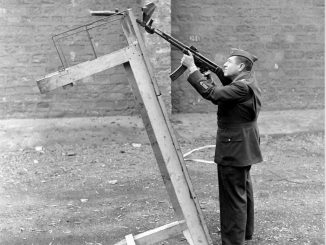This scoped C96 carbine is serial number 12 of the original run of just 30 large-ring C96 carbines. It has the long barrel and detachable stock (in place of the standard pistol grip) of the C96 carbine. The most obvious feature, however, is the telescopic sight mounted on the piece. This was not installed by the Mauser factory, but was added around the time the carbine was originally purchase. The scope and mounts are of the same vintage as the gun (right around 1900).
The scope mount is a quick-detachable claw style typical of German sporting arms, and it fits the C96 carbine quite well. The eye relief and scope height both fit nicely with the stock position, and I expect this would be a very nice and comfortable piece to shoot.
In many ways, this reflects the same type of use we see today with pistol-caliber carbines and low-power compact optics. People assume that tactical is a new thing, but it really isn;t – they just did it more stylishly a hundred years ago.




Ian,
Interesting piece, do you think the magazine can be stripper clip loaded with the scope in place or do you have to remove it to do that?
I think the Luger Carbines were meant to be shot with a heaver, but still factory load, partly to help cycling with the heavier than normal barrel-receiver assembly, do you know if this Mauser carbine also had a special load for it?
Khales was a well known scope brand in Europe before WWII, I think the name was bought by Swarovski and has been recently revived in Europe.
Great stuff! thanks.
Jim
It looks like even with the scope removed, the scope mount causes slight obstruction that requires each bullet to be loaded from the rear and pushed forward, one at a time. Just guessing.
You could always reload it by removing the floorplate? I have always wanted to try that as for me, loading with a stripper is a pain in the arse. If I can find my box of ammo I misplaced I will try that with mind. In a sporting weapon, a quick reload would not be necessary I would not think.
Jim it looks like it may be a detachable box mag if you look at the pictures.
No, the video shows it’s a standard top feed.
Scope looks to be beaten by each fired empty case in such a pistol having the extractor at top and the ejector just at the underside in the middle.
I guess hiding behind a horse cart wouldn’t save anyone from that carbine. The reasons being penetration power of the cartridge and accuracy through the longer barrel. The only problem is that one must remove the scope in order to reload the magazine… or am I wrong? In any case, pistol carbines generally go to rich people or cops. The latter group usually doesn’t like juggling multiple small arms calibers at one time, so having a medium range weapon chambered for the same pistol round eliminates one head ache. On the other hand one could grab the shotgun instead to avoid the excessive force accusations associated with military grade 7.63×25 Mauser…
Did I mess up?
I don’t think police would get excessive force accusations from any pistol caliber weapon. This gun is so early that even in Europe police were still using revolvers, often chambered for the same cartridge as the various national military revolvers. The Browning M1900 was the first semi-auto pistol widely adopted by European police forces, followed by the M1910 etc.
Uh, you’re forgetting about the excessive force associated with a Thompson M1921 and 50 round drum. I’m not sure if the designation is correct but that weapon is pistol caliber and considered overkill at point blank.
In Europe police regularly uses SMGs, although the ones used by regular police (as opposed to SWAT type units) are often limited to semi-auto only. Before WW2 SMGs were not as common, but I believe even in the US the complaints about the Thompson were related to full-auto use of the gun. I don’t think anyone would have complained about a semi-auto pistol caliber carbine.
There existed self-loading version of Thompson sub-machine gun: Thompson Semi-Automatic Carbine also known as Model 1927:
https://en.wikipedia.org/wiki/Thompson_submachine_gun#Semi-automatic
Addendum:
I though that when creating self-loading weapon from Thompson sub-machine gun is possible and should give properly functioning weapon, it would be also unnecessary heavy – in case of selective-fire weapon it is useful for easier control in full-auto, in case of self-loading weapon it will be rather drawback that advantage – self-loading weapon firing .45 Auto (or ballistic-wise similar) don’t have to be ~4.7 kg (empty) heavy.
For comparison M50 Reising sub-machine gun mass was 3.06 kg (empty), you might say that this weapon was unreliable, but it was – so far I know – caused by fact that parts were NOT interchangeable between different examples, not too light construction.
(not counting Han Solo) That is the second time I can recall ever seeing a C96 with a scope!
http://www.imfdb.org/wiki/Three_Days_of_the_Condor#Mauser_C96
Oliver Reed used a scoped Schnellfeuer in the 1972 movie Sitting Target;
http://www.imdb.com/title/tt0069273/mediaviewer/rm2181821440
Interestingly, the pistol was modified by Simon Atherton, who later created Solo’s “BlasTech DL-44” for the original Star Wars trilogy, as well as performing armorer duties on the Indiana Jones movies.
There was also a scoped and sound-suppressed Broomhandle carbine in the 1967 spy movie The Naked Runner, starring Frank Sinatra;
http://i.dailymail.co.uk/i/pix/2016/01/15/11/302863B300000578-3399167-Sinatra_on_the_set_of_the_Naked_Runner_in_1967_as_he_points_a_gu-a-16_1452856199207.jpg
cheers
eon
Being a passionate collector and a follower of Ian’s channel I couldn’t mention an unusual rear sight on this one. I have quite a few C-96 pistols in my collection (round 20-30 pieces) don’t know exactly, from early cone hammers to late 712 and presentation factory engraved piece.
The only one I have ever seen with a “U” shaped rear sight cut out is C-96 Cone Hammer Target Model prototype that is in my collection. That pistol has its “i” shape front sight in a ring that makes the “U” shaped rear sight cutout reasonable. All other C-96 I have ever seen have a “V” shape cutout.
Strongarm – good comment! I have also spotted straight away that brass will always hit the scope. Without the cope it always tends to get into your collar after each shot.
Did it have any dents?
These early sights were never reliable and I’ve used one some time ago…. A pure nightmare to zero it, a pain to gold the zero and a total disaster with humidity…..
“These early sights were never reliable and I’ve used one some time ago…. A pure nightmare to zero it, a pain to gold the zero and a total disaster with humidity…..”
But at least with the low magnification and small objective lens size, focus (and depth of field) is not a major concern.
Besides the [thankfully temporary] dreaded lens fogging, the humidity issue seems to have another, longer term effect, as rust and corrosion (as well as plain dirt and dirt) apparently builds up on the internal surfaces, which can’t be easily accessed and cleaned.
I’ve wondered if dunking the whole thing in lens cleaning fluid (Freon, solvent, or whatever else) until about half the air bubbles out, shaking vigorously (both to swish fluid around the internals and then to force-drain it out the openings) — would this sort of thing potentially work as a cleaning method or would it likely make the situation worse?
By “worse” I’m thinking of the way that an even layer of dust (even if quite thick) on a car’s rear window is much easier to see through than if that dust layer is incompletely wiped off, since the resulting patchiness of clean and dirty areas can be much more visually obstructing than an even, continous, dirty coating which has the effect of acting more like a kind of glass tint.
Just something I’ve wondered about but never dared to take the plunge to find out.
One of the old scopes on an old gun I’ve used had minor issues with layers of dust on lenses, but with every shot some pieces of “time disintegrated lens sealant (big black flakes)” were jumping around the inside of the scope. Most annoying there was that this pieces got stuck on the surface of the inner lenses with every shot and in different places. Sometimes crosshairs were closed and I couldn’t aim properly.
I didn’t want to loose authentic look of an old Mannlicher Schoenauer, so a gunsmith have sent the scope for cleaning and repair. Scope was clear and fixed afterwards, but neither nitrogen filled nor perfectly “clicked”….
The piece looks to be the nominate of “Foolish early tactical attempt”. Difficult to load and, by cause of dangling each fired case under the scope, harmfull to fire. The gunsmith mounting the optic should had seen the fact and objected but the owner of gun should had insisted. He might think the difficulties of zeroing with an offset optics mounting. The gun should have seen very little or no use.
Indeed, reasons why top-mounted scopes had to wait until the advent of bottom-loading magazines and side-eject. But then, this was not the creation of a professional engineer or gun designer, or a commercial product backed by lengthly testing and careful analysis, but just the result of an ordinary customer’s ideas of how a gun should be built — for better or worse — for his own intended use.
“In many ways, this reflects the same type of use we see today with pistol-caliber carbines and low-power compact optics.”
Can you explain me one thing: what is relation between REFLECTOR SIGHTS and OPTIC SIGHTS –
REFLECTOR SIGHTS is subset of OPTIC SIGHTS
xor
intersection(REFLECTOR SIGHTS,OPTIC SIGHTS) is empty
?
If second does anyone to mate pistol-caliber carbine with reflector sight?
I know that REFLECTOR SIGHTS were used during WWII by U.S.Navy in aeroplanes, see photos: http://www.aircraft-gunsights.com/reflector-sights/ and that they need voltage to work – not a problem in aeroplanes, which has electric installation anyway (for wireless set), but might be a problem in carbines, which by default, do not have such installation.
is: “anyone to mate”
should be: “anyone tried to mate”
If it has a lens or mirror, it’s an optical sight. Reflector a.k.a. reflex sights are a type of optical sight which simplify aiming by projecting the aiming reticle so that it appears to be in front of the field of view of the sight and always in alignment with the gun (or other device) aimed. This removes the need to align your eye precisely with the rear and front sights of an iron sight.
The very popular red dot sights are a type of reflector sights with a simple LED dot (usually red) as the reticle. All reflector sights require a power source for projecting the reticle, but LED technology has made them practical on small arms and of course improved battery tech has helped immensely as well.
Reflector sights emerged in the 1920s as light AA gun sights. In WW2 20mm AA guns often had a reflector sight, since lead computing sights were considered too expensive for them, but they were nevertheless a big improvement over simple ring AA sights. They were also experimented with on fighter planes already in WW1, but common use followed more or less concurrently with AA gun sights. They were the most common type of fighter gun sight in WW2 and later evolved into the modern fighter HUD sights.
These days reflector sights are still used as AA sights on heavy machine guns in some countries, again because computing sights are too expensive and possibly heavier and less reliable. Needless to say, by far their most common use today must be as the red dot sights on small arms.
Ian, thanks for taking the time to show us some of these cool and interesting firearms before they vanish into a private collection never to be seen again
That is one of the coolest pieces I have ever seen.